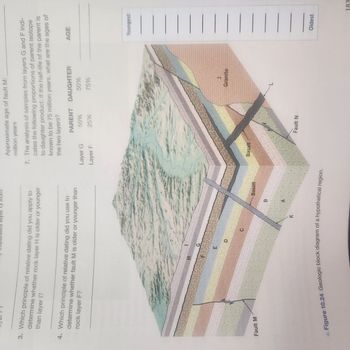
Applications and Investigations in Earth Science (9th Edition)
9th Edition
ISBN: 9780134746241
Author: Edward J. Tarbuck, Frederick K. Lutgens, Dennis G. Tasa
Publisher: PEARSON
expand_more
expand_more
format_list_bulleted
Question

Transcribed Image Text:**Title: Understanding Relative and Absolute Dating in Geology**
**Introduction:**
This educational segment focuses on the principles of relative and absolute dating within geology, aiming to elucidate how scientists determine the age of rock layers and geological events. A critical component of this process involves understanding cross-sectional diagrams and the relationships between various geological features.
**Relative Dating and Geological Principles:**
Relative dating is a method used to determine the sequence of past events by comparing rock layers and their features. Key principles include:
1. **Law of Superposition**: In a sequence of undeformed sedimentary rocks, the oldest layers are at the bottom, and younger layers are at the top.
2. **Principle of Original Horizontality**: Layers of sediments are originally deposited horizontally under the action of gravity.
3. **Principle of Cross-Cutting Relationships**: Geological features such as faults or igneous intrusions are younger than the rocks they cut through.
**Diagram Explanation:**
The provided colored block diagram (Figure 10.24) represents a hypothetical cross-section of a geological region. This diagram is critical for understanding the sequence of geological events and the relative ages of rock layers and faults. The diagram includes various colored and labeled layers and features, such as:
- **Layers (A through J)**: Represent different sedimentary and igneous rock layers.
- **Faults (M and N)**: Represent breaks in the Earth's crust where rocks have been displaced.
- **Intrusions (Basalt and Granite)**: Represent igneous rocks that have intruded into pre-existing formations.
**Detailed Observations:**
For instance:
- **Layer Sequence**: Layers are depicted in a horizontal arrangement and labeled from G (at the top) to J (at the bottom), adhering to the Principle of Superposition.
- **Fault M**: Cuts through several layers indicating it is younger than the layers it disrupts, as per the Principle of Cross-Cutting Relationships.
- **Basalt Intrusion**: Cuts through and alters multiple layers, providing important information about the relative timing of geological events.
**Exercises:**
1. **Determining Layer Ages**: Apply the principles of relative dating to determine whether fault M is older or younger than layer F.
2. **Relative Dating Questions**:
- Which principle did you apply to determine whether fault M is older or younger than layer F?
- Which principle of relative dating did you use to detect whether fault N is
Expert Solution
This question has been solved!
Explore an expertly crafted, step-by-step solution for a thorough understanding of key concepts.
Step by stepSolved in 3 steps

Knowledge Booster
Recommended textbooks for you
 Applications and Investigations in Earth Science ...Earth ScienceISBN:9780134746241Author:Edward J. Tarbuck, Frederick K. Lutgens, Dennis G. TasaPublisher:PEARSON
Applications and Investigations in Earth Science ...Earth ScienceISBN:9780134746241Author:Edward J. Tarbuck, Frederick K. Lutgens, Dennis G. TasaPublisher:PEARSON Exercises for Weather & Climate (9th Edition)Earth ScienceISBN:9780134041360Author:Greg CarbonePublisher:PEARSON
Exercises for Weather & Climate (9th Edition)Earth ScienceISBN:9780134041360Author:Greg CarbonePublisher:PEARSON Environmental ScienceEarth ScienceISBN:9781260153125Author:William P Cunningham Prof., Mary Ann Cunningham ProfessorPublisher:McGraw-Hill Education
Environmental ScienceEarth ScienceISBN:9781260153125Author:William P Cunningham Prof., Mary Ann Cunningham ProfessorPublisher:McGraw-Hill Education Earth Science (15th Edition)Earth ScienceISBN:9780134543536Author:Edward J. Tarbuck, Frederick K. Lutgens, Dennis G. TasaPublisher:PEARSON
Earth Science (15th Edition)Earth ScienceISBN:9780134543536Author:Edward J. Tarbuck, Frederick K. Lutgens, Dennis G. TasaPublisher:PEARSON Environmental Science (MindTap Course List)Earth ScienceISBN:9781337569613Author:G. Tyler Miller, Scott SpoolmanPublisher:Cengage Learning
Environmental Science (MindTap Course List)Earth ScienceISBN:9781337569613Author:G. Tyler Miller, Scott SpoolmanPublisher:Cengage Learning Physical GeologyEarth ScienceISBN:9781259916823Author:Plummer, Charles C., CARLSON, Diane H., Hammersley, LisaPublisher:Mcgraw-hill Education,
Physical GeologyEarth ScienceISBN:9781259916823Author:Plummer, Charles C., CARLSON, Diane H., Hammersley, LisaPublisher:Mcgraw-hill Education,

Applications and Investigations in Earth Science ...
Earth Science
ISBN:9780134746241
Author:Edward J. Tarbuck, Frederick K. Lutgens, Dennis G. Tasa
Publisher:PEARSON

Exercises for Weather & Climate (9th Edition)
Earth Science
ISBN:9780134041360
Author:Greg Carbone
Publisher:PEARSON

Environmental Science
Earth Science
ISBN:9781260153125
Author:William P Cunningham Prof., Mary Ann Cunningham Professor
Publisher:McGraw-Hill Education

Earth Science (15th Edition)
Earth Science
ISBN:9780134543536
Author:Edward J. Tarbuck, Frederick K. Lutgens, Dennis G. Tasa
Publisher:PEARSON

Environmental Science (MindTap Course List)
Earth Science
ISBN:9781337569613
Author:G. Tyler Miller, Scott Spoolman
Publisher:Cengage Learning

Physical Geology
Earth Science
ISBN:9781259916823
Author:Plummer, Charles C., CARLSON, Diane H., Hammersley, Lisa
Publisher:Mcgraw-hill Education,